Understanding the Process of Protein Synthesis in Biology
VerifiedAdded on 2019/09/19
|6
|1904
|406
Homework Assignment
AI Summary
This document provides a detailed overview of protein synthesis, a fundamental biological process where cells create proteins. It explains the two main stages: transcription and translation. Transcription involves copying the genetic information from DNA to RNA, specifically messenger RNA (mRNA). This process occurs in the nucleus and is catalyzed by RNA polymerase. Translation, which takes place in the cytoplasm, involves ribosomes reading the mRNA sequence to assemble amino acids into a polypeptide chain. Transfer RNA (tRNA) molecules bring the correct amino acids to the ribosome based on the mRNA codons. The document describes the roles of mRNA, tRNA, ribosomes, codons, and anticodons. It also covers the concept of recombinant DNA technology and its applications in producing therapeutic substances. The document also describes the process of protein synthesis from the start codon to the stop codon.
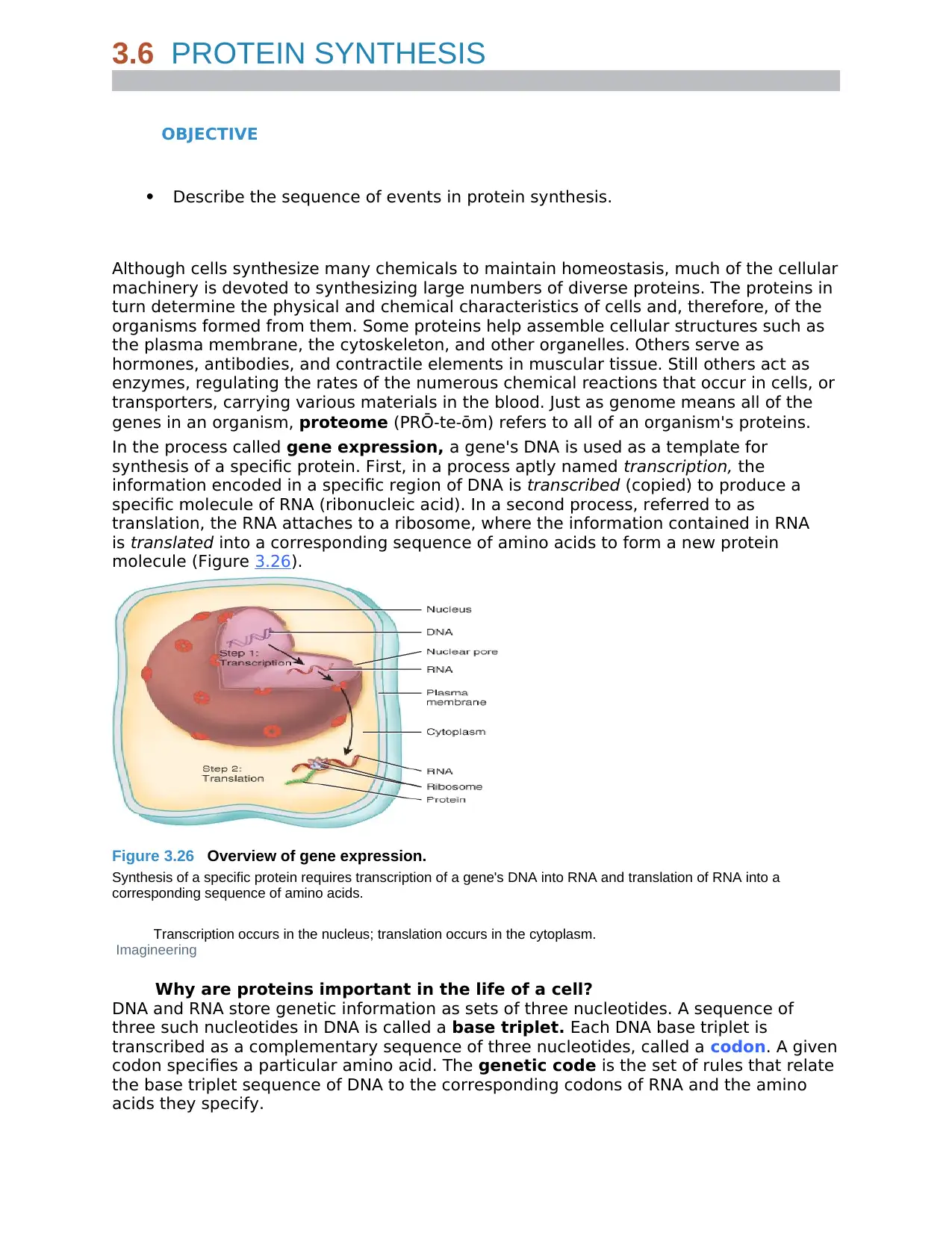
3.6 PROTEIN SYNTHESIS
OBJECTIVE
• Describe the sequence of events in protein synthesis.
Although cells synthesize many chemicals to maintain homeostasis, much of the cellular
machinery is devoted to synthesizing large numbers of diverse proteins. The proteins in
turn determine the physical and chemical characteristics of cells and, therefore, of the
organisms formed from them. Some proteins help assemble cellular structures such as
the plasma membrane, the cytoskeleton, and other organelles. Others serve as
hormones, antibodies, and contractile elements in muscular tissue. Still others act as
enzymes, regulating the rates of the numerous chemical reactions that occur in cells, or
transporters, carrying various materials in the blood. Just as genome means all of the
genes in an organism, proteome (PRŌ‐te‐ōm) refers to all of an organism's proteins.
In the process called gene expression, a gene's DNA is used as a template for
synthesis of a specific protein. First, in a process aptly named transcription, the
information encoded in a specific region of DNA is transcribed (copied) to produce a
specific molecule of RNA (ribonucleic acid). In a second process, referred to as
translation, the RNA attaches to a ribosome, where the information contained in RNA
is translated into a corresponding sequence of amino acids to form a new protein
molecule (Figure 3.26).
Figure 3.26 Overview of gene expression.
Synthesis of a specific protein requires transcription of a gene's DNA into RNA and translation of RNA into a
corresponding sequence of amino acids.
Transcription occurs in the nucleus; translation occurs in the cytoplasm.
Imagineering
Why are proteins important in the life of a cell?
DNA and RNA store genetic information as sets of three nucleotides. A sequence of
three such nucleotides in DNA is called a base triplet. Each DNA base triplet is
transcribed as a complementary sequence of three nucleotides, called a codon. A given
codon specifies a particular amino acid. The genetic code is the set of rules that relate
the base triplet sequence of DNA to the corresponding codons of RNA and the amino
acids they specify.
OBJECTIVE
• Describe the sequence of events in protein synthesis.
Although cells synthesize many chemicals to maintain homeostasis, much of the cellular
machinery is devoted to synthesizing large numbers of diverse proteins. The proteins in
turn determine the physical and chemical characteristics of cells and, therefore, of the
organisms formed from them. Some proteins help assemble cellular structures such as
the plasma membrane, the cytoskeleton, and other organelles. Others serve as
hormones, antibodies, and contractile elements in muscular tissue. Still others act as
enzymes, regulating the rates of the numerous chemical reactions that occur in cells, or
transporters, carrying various materials in the blood. Just as genome means all of the
genes in an organism, proteome (PRŌ‐te‐ōm) refers to all of an organism's proteins.
In the process called gene expression, a gene's DNA is used as a template for
synthesis of a specific protein. First, in a process aptly named transcription, the
information encoded in a specific region of DNA is transcribed (copied) to produce a
specific molecule of RNA (ribonucleic acid). In a second process, referred to as
translation, the RNA attaches to a ribosome, where the information contained in RNA
is translated into a corresponding sequence of amino acids to form a new protein
molecule (Figure 3.26).
Figure 3.26 Overview of gene expression.
Synthesis of a specific protein requires transcription of a gene's DNA into RNA and translation of RNA into a
corresponding sequence of amino acids.
Transcription occurs in the nucleus; translation occurs in the cytoplasm.
Imagineering
Why are proteins important in the life of a cell?
DNA and RNA store genetic information as sets of three nucleotides. A sequence of
three such nucleotides in DNA is called a base triplet. Each DNA base triplet is
transcribed as a complementary sequence of three nucleotides, called a codon. A given
codon specifies a particular amino acid. The genetic code is the set of rules that relate
the base triplet sequence of DNA to the corresponding codons of RNA and the amino
acids they specify.
Paraphrase This Document
Need a fresh take? Get an instant paraphrase of this document with our AI Paraphraser

Examples
Animation: Protein Synthesis
Transcription
During transcription, which occurs in the nucleus, the genetic information represented
by the sequence of base triplets in DNA serves as a template for copying the
information into a complementary sequence of codons. Three types of RNA are made
from the DNA template:
1. Messenger RNA (mRNA) directs the synthesis of a protein.
2. Ribosomal RNA (rRNA) joins with ribosomal proteins to make ribosomes.
3. Transfer RNA (tRNA) binds to an amino acid and holds it in place on a
ribosome until it is incorporated into a protein during translation. One end of the
tRNA carries a specific amino acid, and the opposite end consists of a triplet of
nucleotides called an anticodon. By pairing between complementary bases, the
tRNA anticodon attaches to the mRNA codon. Each of the more than 20 different
types of tRNA binds to only one of the 20 different amino acids.
The enzyme RNA polymerase (po‐LIM‐er‐ās) catalyzes transcription of DNA. However,
the enzyme must be instructed where to start the transcription process and where to
end it. Only one of the two DNA strands serves as a template for RNA synthesis. The
segment of DNA where transcription begins, a special nucleotide sequence called
a promoter, is located near the beginning of a gene (Figure 3.27a). This is where RNA
polymerase attaches to the DNA. During transcription, bases pair in a complementary
manner: The bases cytosine (C), guanine (G), and thymine (T) in the DNA template pair
with guanine, cytosine, and adenine (A), respectively, in the RNA strand (Figure 3.27b).
However, adenine in the DNA template pairs with uracil (U), not thymine, in RNA:
A U
T A
G C
→
C G
A U
T A
Template DNA base
sequence
Complementary RNA base
sequence
Animation: Protein Synthesis
Transcription
During transcription, which occurs in the nucleus, the genetic information represented
by the sequence of base triplets in DNA serves as a template for copying the
information into a complementary sequence of codons. Three types of RNA are made
from the DNA template:
1. Messenger RNA (mRNA) directs the synthesis of a protein.
2. Ribosomal RNA (rRNA) joins with ribosomal proteins to make ribosomes.
3. Transfer RNA (tRNA) binds to an amino acid and holds it in place on a
ribosome until it is incorporated into a protein during translation. One end of the
tRNA carries a specific amino acid, and the opposite end consists of a triplet of
nucleotides called an anticodon. By pairing between complementary bases, the
tRNA anticodon attaches to the mRNA codon. Each of the more than 20 different
types of tRNA binds to only one of the 20 different amino acids.
The enzyme RNA polymerase (po‐LIM‐er‐ās) catalyzes transcription of DNA. However,
the enzyme must be instructed where to start the transcription process and where to
end it. Only one of the two DNA strands serves as a template for RNA synthesis. The
segment of DNA where transcription begins, a special nucleotide sequence called
a promoter, is located near the beginning of a gene (Figure 3.27a). This is where RNA
polymerase attaches to the DNA. During transcription, bases pair in a complementary
manner: The bases cytosine (C), guanine (G), and thymine (T) in the DNA template pair
with guanine, cytosine, and adenine (A), respectively, in the RNA strand (Figure 3.27b).
However, adenine in the DNA template pairs with uracil (U), not thymine, in RNA:
A U
T A
G C
→
C G
A U
T A
Template DNA base
sequence
Complementary RNA base
sequence
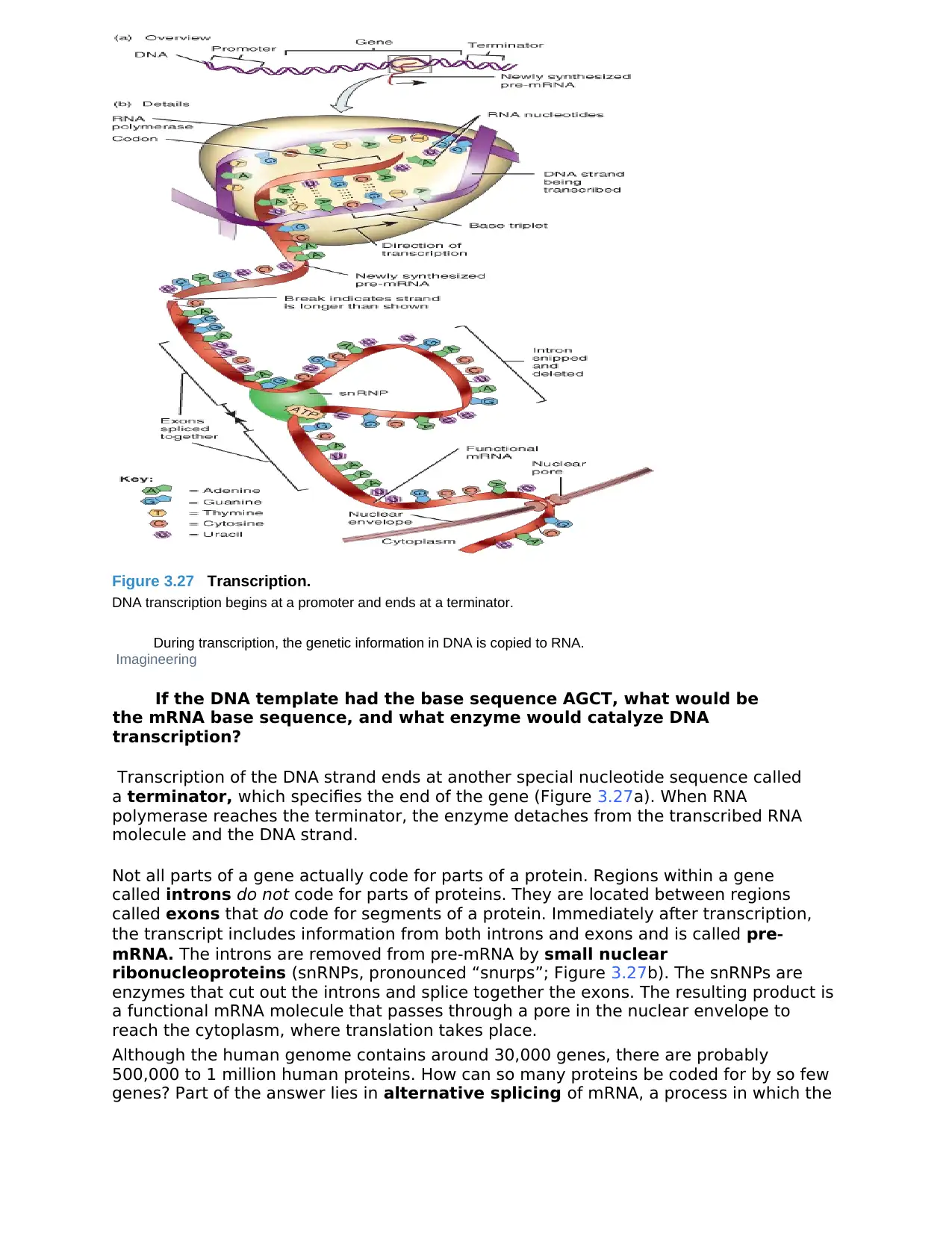
Figure 3.27 Transcription.
DNA transcription begins at a promoter and ends at a terminator.
During transcription, the genetic information in DNA is copied to RNA.
Imagineering
If the DNA template had the base sequence AGCT, what would be
the mRNA base sequence, and what enzyme would catalyze DNA
transcription?
Transcription of the DNA strand ends at another special nucleotide sequence called
a terminator, which specifies the end of the gene (Figure 3.27a). When RNA
polymerase reaches the terminator, the enzyme detaches from the transcribed RNA
molecule and the DNA strand.
Not all parts of a gene actually code for parts of a protein. Regions within a gene
called introns do not code for parts of proteins. They are located between regions
called exons that do code for segments of a protein. Immediately after transcription,
the transcript includes information from both introns and exons and is called pre‐
mRNA. The introns are removed from pre‐mRNA by small nuclear
ribonucleoproteins (snRNPs, pronounced “snurps”; Figure 3.27b). The snRNPs are
enzymes that cut out the introns and splice together the exons. The resulting product is
a functional mRNA molecule that passes through a pore in the nuclear envelope to
reach the cytoplasm, where translation takes place.
Although the human genome contains around 30,000 genes, there are probably
500,000 to 1 million human proteins. How can so many proteins be coded for by so few
genes? Part of the answer lies in alternative splicing of mRNA, a process in which the
DNA transcription begins at a promoter and ends at a terminator.
During transcription, the genetic information in DNA is copied to RNA.
Imagineering
If the DNA template had the base sequence AGCT, what would be
the mRNA base sequence, and what enzyme would catalyze DNA
transcription?
Transcription of the DNA strand ends at another special nucleotide sequence called
a terminator, which specifies the end of the gene (Figure 3.27a). When RNA
polymerase reaches the terminator, the enzyme detaches from the transcribed RNA
molecule and the DNA strand.
Not all parts of a gene actually code for parts of a protein. Regions within a gene
called introns do not code for parts of proteins. They are located between regions
called exons that do code for segments of a protein. Immediately after transcription,
the transcript includes information from both introns and exons and is called pre‐
mRNA. The introns are removed from pre‐mRNA by small nuclear
ribonucleoproteins (snRNPs, pronounced “snurps”; Figure 3.27b). The snRNPs are
enzymes that cut out the introns and splice together the exons. The resulting product is
a functional mRNA molecule that passes through a pore in the nuclear envelope to
reach the cytoplasm, where translation takes place.
Although the human genome contains around 30,000 genes, there are probably
500,000 to 1 million human proteins. How can so many proteins be coded for by so few
genes? Part of the answer lies in alternative splicing of mRNA, a process in which the
⊘ This is a preview!⊘
Do you want full access?
Subscribe today to unlock all pages.

Trusted by 1+ million students worldwide
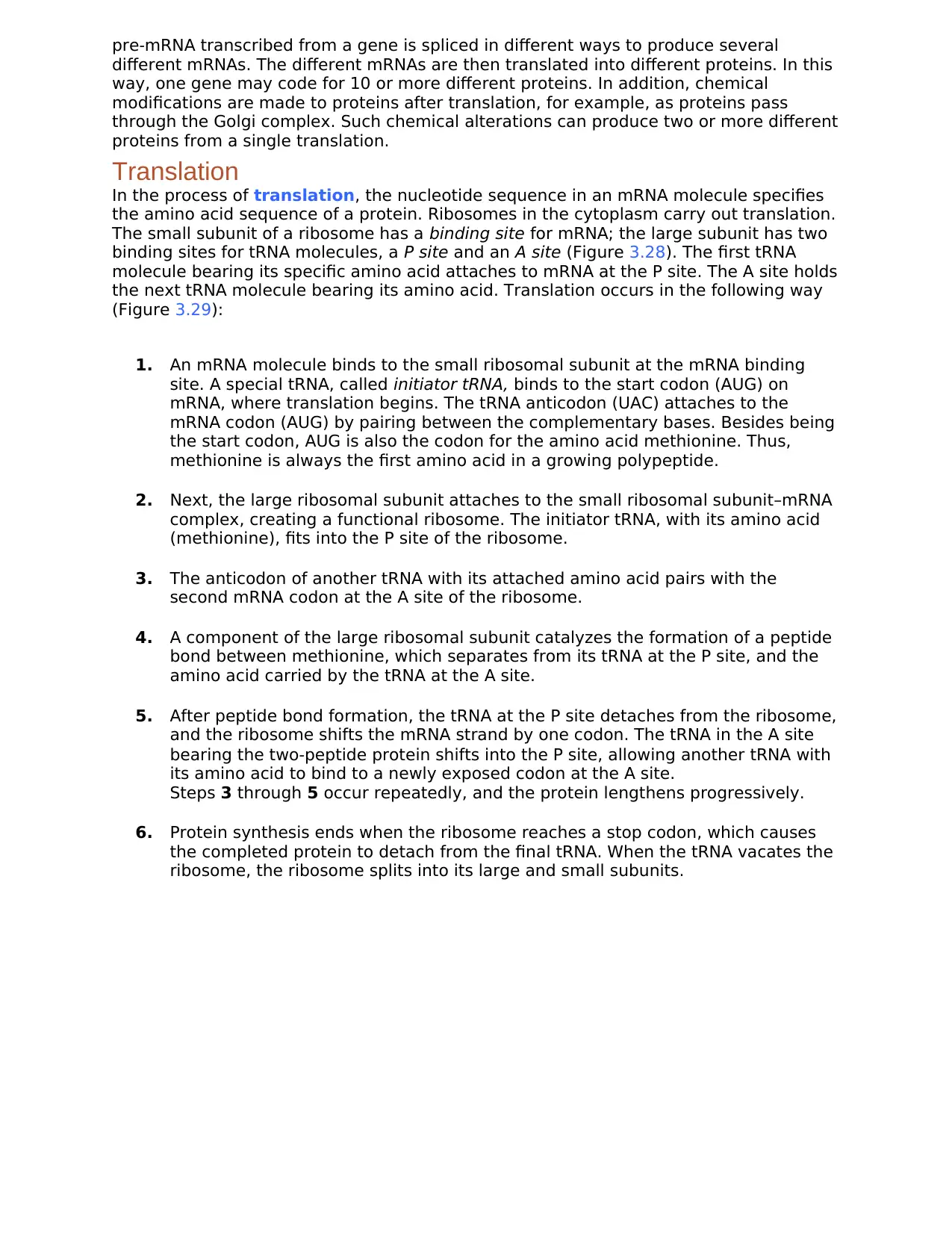
pre‐mRNA transcribed from a gene is spliced in different ways to produce several
different mRNAs. The different mRNAs are then translated into different proteins. In this
way, one gene may code for 10 or more different proteins. In addition, chemical
modifications are made to proteins after translation, for example, as proteins pass
through the Golgi complex. Such chemical alterations can produce two or more different
proteins from a single translation.
Translation
In the process of translation, the nucleotide sequence in an mRNA molecule specifies
the amino acid sequence of a protein. Ribosomes in the cytoplasm carry out translation.
The small subunit of a ribosome has a binding site for mRNA; the large subunit has two
binding sites for tRNA molecules, a P site and an A site (Figure 3.28). The first tRNA
molecule bearing its specific amino acid attaches to mRNA at the P site. The A site holds
the next tRNA molecule bearing its amino acid. Translation occurs in the following way
(Figure 3.29):
1. An mRNA molecule binds to the small ribosomal subunit at the mRNA binding
site. A special tRNA, called initiator tRNA, binds to the start codon (AUG) on
mRNA, where translation begins. The tRNA anticodon (UAC) attaches to the
mRNA codon (AUG) by pairing between the complementary bases. Besides being
the start codon, AUG is also the codon for the amino acid methionine. Thus,
methionine is always the first amino acid in a growing polypeptide.
2. Next, the large ribosomal subunit attaches to the small ribosomal subunit–mRNA
complex, creating a functional ribosome. The initiator tRNA, with its amino acid
(methionine), fits into the P site of the ribosome.
3. The anticodon of another tRNA with its attached amino acid pairs with the
second mRNA codon at the A site of the ribosome.
4. A component of the large ribosomal subunit catalyzes the formation of a peptide
bond between methionine, which separates from its tRNA at the P site, and the
amino acid carried by the tRNA at the A site.
5. After peptide bond formation, the tRNA at the P site detaches from the ribosome,
and the ribosome shifts the mRNA strand by one codon. The tRNA in the A site
bearing the two‐peptide protein shifts into the P site, allowing another tRNA with
its amino acid to bind to a newly exposed codon at the A site.
Steps 3 through 5 occur repeatedly, and the protein lengthens progressively.
6. Protein synthesis ends when the ribosome reaches a stop codon, which causes
the completed protein to detach from the final tRNA. When the tRNA vacates the
ribosome, the ribosome splits into its large and small subunits.
different mRNAs. The different mRNAs are then translated into different proteins. In this
way, one gene may code for 10 or more different proteins. In addition, chemical
modifications are made to proteins after translation, for example, as proteins pass
through the Golgi complex. Such chemical alterations can produce two or more different
proteins from a single translation.
Translation
In the process of translation, the nucleotide sequence in an mRNA molecule specifies
the amino acid sequence of a protein. Ribosomes in the cytoplasm carry out translation.
The small subunit of a ribosome has a binding site for mRNA; the large subunit has two
binding sites for tRNA molecules, a P site and an A site (Figure 3.28). The first tRNA
molecule bearing its specific amino acid attaches to mRNA at the P site. The A site holds
the next tRNA molecule bearing its amino acid. Translation occurs in the following way
(Figure 3.29):
1. An mRNA molecule binds to the small ribosomal subunit at the mRNA binding
site. A special tRNA, called initiator tRNA, binds to the start codon (AUG) on
mRNA, where translation begins. The tRNA anticodon (UAC) attaches to the
mRNA codon (AUG) by pairing between the complementary bases. Besides being
the start codon, AUG is also the codon for the amino acid methionine. Thus,
methionine is always the first amino acid in a growing polypeptide.
2. Next, the large ribosomal subunit attaches to the small ribosomal subunit–mRNA
complex, creating a functional ribosome. The initiator tRNA, with its amino acid
(methionine), fits into the P site of the ribosome.
3. The anticodon of another tRNA with its attached amino acid pairs with the
second mRNA codon at the A site of the ribosome.
4. A component of the large ribosomal subunit catalyzes the formation of a peptide
bond between methionine, which separates from its tRNA at the P site, and the
amino acid carried by the tRNA at the A site.
5. After peptide bond formation, the tRNA at the P site detaches from the ribosome,
and the ribosome shifts the mRNA strand by one codon. The tRNA in the A site
bearing the two‐peptide protein shifts into the P site, allowing another tRNA with
its amino acid to bind to a newly exposed codon at the A site.
Steps 3 through 5 occur repeatedly, and the protein lengthens progressively.
6. Protein synthesis ends when the ribosome reaches a stop codon, which causes
the completed protein to detach from the final tRNA. When the tRNA vacates the
ribosome, the ribosome splits into its large and small subunits.
Paraphrase This Document
Need a fresh take? Get an instant paraphrase of this document with our AI Paraphraser
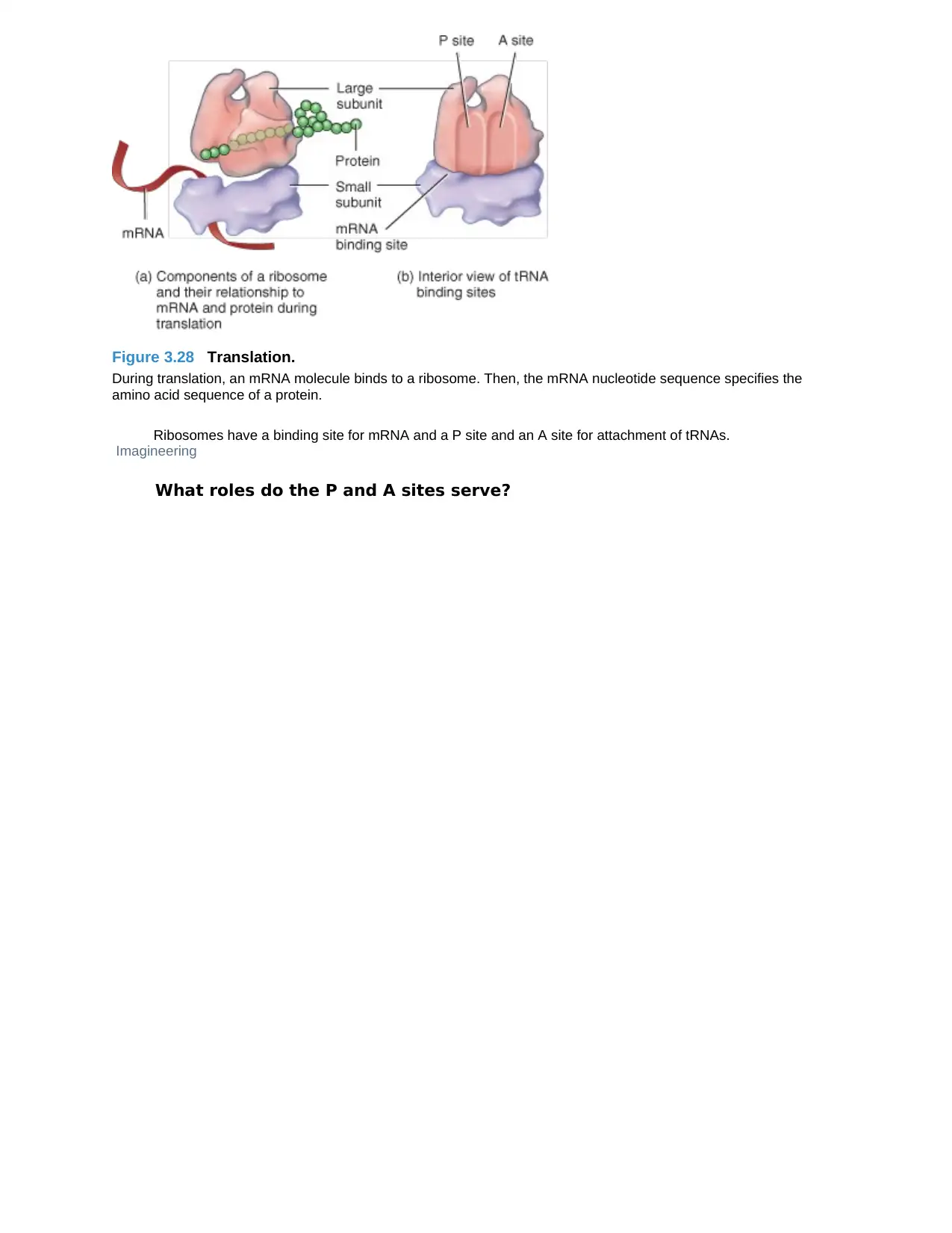
Figure 3.28 Translation.
During translation, an mRNA molecule binds to a ribosome. Then, the mRNA nucleotide sequence specifies the
amino acid sequence of a protein.
Ribosomes have a binding site for mRNA and a P site and an A site for attachment of tRNAs.
Imagineering
What roles do the P and A sites serve?
During translation, an mRNA molecule binds to a ribosome. Then, the mRNA nucleotide sequence specifies the
amino acid sequence of a protein.
Ribosomes have a binding site for mRNA and a P site and an A site for attachment of tRNAs.
Imagineering
What roles do the P and A sites serve?
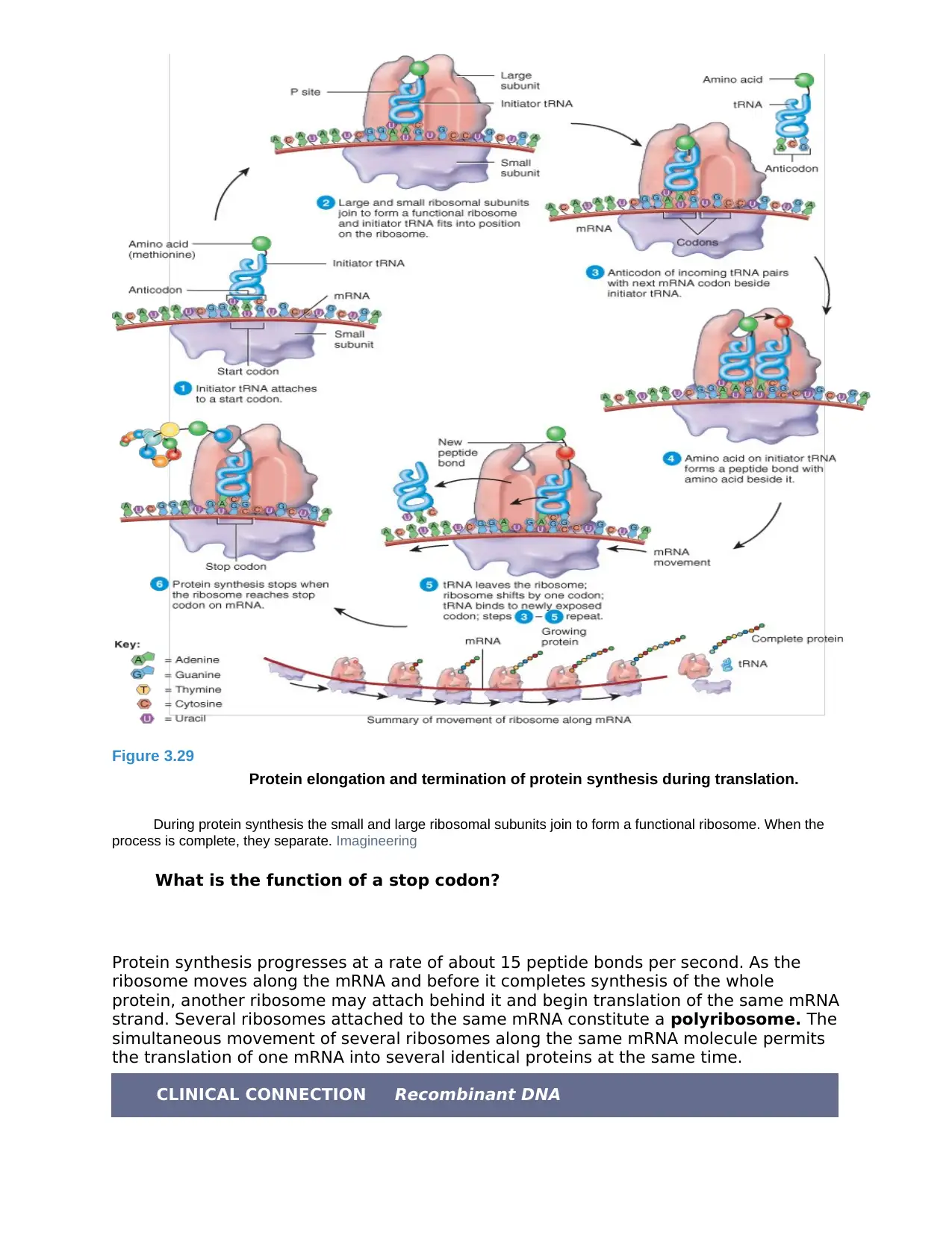
Figure 3.29
Protein elongation and termination of protein synthesis during translation.
During protein synthesis the small and large ribosomal subunits join to form a functional ribosome. When the
process is complete, they separate. Imagineering
What is the function of a stop codon?
Protein synthesis progresses at a rate of about 15 peptide bonds per second. As the
ribosome moves along the mRNA and before it completes synthesis of the whole
protein, another ribosome may attach behind it and begin translation of the same mRNA
strand. Several ribosomes attached to the same mRNA constitute a polyribosome. The
simultaneous movement of several ribosomes along the same mRNA molecule permits
the translation of one mRNA into several identical proteins at the same time.
CLINICAL CONNECTION Recombinant DNA
Protein elongation and termination of protein synthesis during translation.
During protein synthesis the small and large ribosomal subunits join to form a functional ribosome. When the
process is complete, they separate. Imagineering
What is the function of a stop codon?
Protein synthesis progresses at a rate of about 15 peptide bonds per second. As the
ribosome moves along the mRNA and before it completes synthesis of the whole
protein, another ribosome may attach behind it and begin translation of the same mRNA
strand. Several ribosomes attached to the same mRNA constitute a polyribosome. The
simultaneous movement of several ribosomes along the same mRNA molecule permits
the translation of one mRNA into several identical proteins at the same time.
CLINICAL CONNECTION Recombinant DNA
⊘ This is a preview!⊘
Do you want full access?
Subscribe today to unlock all pages.

Trusted by 1+ million students worldwide
1 out of 6
Related Documents
Your All-in-One AI-Powered Toolkit for Academic Success.
+13062052269
info@desklib.com
Available 24*7 on WhatsApp / Email
![[object Object]](/_next/static/media/star-bottom.7253800d.svg)
Unlock your academic potential
Copyright © 2020–2025 A2Z Services. All Rights Reserved. Developed and managed by ZUCOL.





